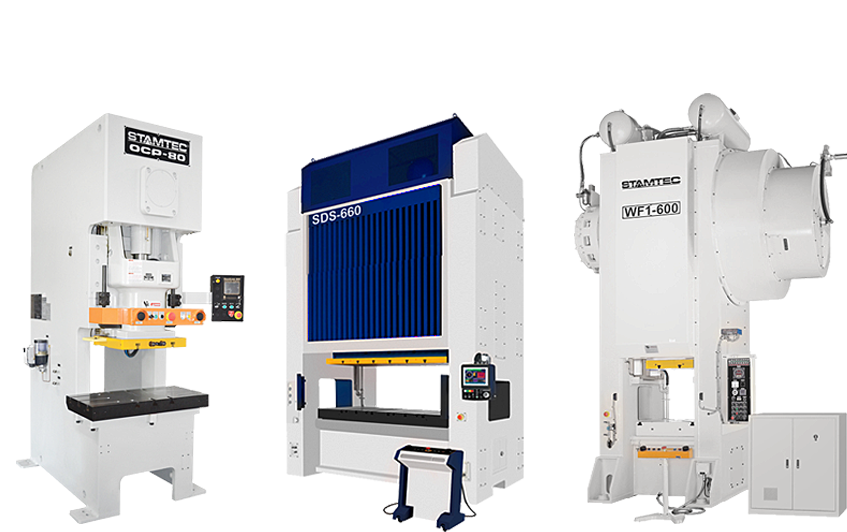
A straight side press is a critical piece of equipment used in the manufacturing and metal stamping industries. It's characterized by a sturdy, vertical frame that effectively resists deflection under load. This makes a mechanical straight sided press ideal for operations requiring high tonnage and exacting standards.
Whether you're deeply embedded in the engineering field or just beginning to navigate the complexities of manufacturing, this comprehensive overview promises to provide a thorough understanding of mechanical straight side presses, highlighting their benefits, uses and why
they could be the ideal choice for advancing your manufacturing capabilities.
Choosing the right type of press for your manufacturing needs is crucial to maximizing efficiency, precision, and reliability in your production line. While the debate over the mechanical press vs. hydraulic press has been extensive, the emergence of servo presses introduces a game-changing perspective. This comparison article will clarify the capabilities, limitations, distinctions, and applications of these traditional technologies and briefly touch on servo presses as a great alternative for many modern manufacturers, especially those in the metal stamping and automotive industries.

A mechanical press generates force by using a motor coupled with a mechanical flywheel. It's a fundamental tool in metal forming, renowned for its high-speed capabilities and dependability. The mechanical press is also an essential asset in high-volume manufacturing environments.
A Mechanical Press plays a vital role in various industries, driving the production of diverse parts through precise movements controlled by sophisticated press drives. Understanding the intricate dynamics of these drives is crucial for optimizing performance and achieving desired production outcomes.
Table Of Contents
At Stamtec, we recognize the multifaceted requirements of stamping operations, which is why we offer a comprehensive range of mechanical press machine drive options tailored to suit different applications and stamping needs.
One of the most important is the drive that controls the movement of the die and directly affects the type of part produced. Selecting the right drive depends on several application requirements, including:
Our drive train offerings include:
Mechanical Presses are the workhorses of the manufacturing world, producing millions of parts for a wide range of critical applications. Here’s a deep dive into the world of mechanical presses.
How does a mechanical press work?
Powered by an electric motor, a flywheel is engaged by a clutch and brake, driving a gear train that transmits the power to the crankshaft, which moves the press slide up and down. The motor then restores the energy to the flywheel, and the process begins again. The flywheel’s mass and speed determine the working energy of the press.
What are the advantages of using a mechanical press?
Mechanical presses are relatively inexpensive. Other advantages include fast production rates, very repeatable action with precision accuracy, and simple set-up and operation.
What applications are best suited to mechanical presses?
Mechanical presses are frequently used for flat to medium-depth drawn parts, like automotive, appliance and hardware components.
Servo Presses offer the best of both worlds – the slide velocity variability of hydraulic presses at the same or faster production speeds than mechanical presses.
The servo motors and controls that run servo presses account for the combined benefit of flexibility and speed.
But let’s step back and take a look at traditional mechanical presses to understand why servo presses are different. In mechanical presses, the flywheel mass and speed determine the amount of working energy available to form a part. This works well until a slower slide velocity is required to form the part effectively (since metal generally flows and forms better at slower speeds). To achieve the slower slide velocity, the flywheel needs to rotate more slowly, which diminishes the amount of working energy, preventing the press from properly forming the part.
For more than 100 years, mechanical presses have been the mainstays of the metal-stamping world. They remain the most cost-effective solution for a high-production metal parts manufacturing system. Let’s take a closer look at these mechanical marvels.
From an operational standpoint, mechanical presses are straightforward: an electric motor supplies power to a flywheel that, when engaged by a clutch and brake, drives a gear train that transmits the power to the crankshaft, which moves the press slide up and down. The motor then restores the energy to the flywheel, and the process begins again. The working energy of the press depends on the flywheel’s mass and speed.
Press Advantages
These stamping machines offer a variety of advantages:
The two basic types of mechanical presses – gap frame and straight side – also offer their own benefits. Gap frame presses work well with smaller dies and provide easier access around the die. Straight side presses, offering greater rigidity and not as much deflection, provide higher accuracy and are usually more suitable for progressive die work.